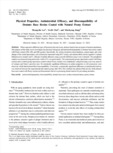

PARTNER
검증된 파트너 제휴사 자료
Physical Properties, Antimicrobial Efficacy, and Biocompatibility of Denture Base Resins Coated with Natural Peony Extract
7 페이지
최초등록일 2023.04.10
최종저작일
2023.02

-
 * 본 문서는 배포용으로 복사 및 편집이 불가합니다.
* 본 문서는 배포용으로 복사 및 편집이 불가합니다.
미리보기
서지정보
· 발행기관 : 한국재료학회
· 수록지 정보 : 한국재료학회지 / 33권 / 2호
· 저자명 : Myung-Jin Lee, Yu-Ri Choi, Min-Kyung Kang
목차
Abstract
1. Introduction
2. Experimental Procedure
2.1. Extraction
2.2. Preparation of denture base resin coated withPeony extract
2.3. Measurement of microhardness
2.4. Water contact angle measurement
2.5. Measurement of color difference
2.6. Polyphenols content measurement
2.7. Evaluation of cytotoxicity
2.8. Antimicrobial tests
2.9. Statistical analysis
3. Results and Discussion
4. Conclusions
References영어초록
When exposed to different types of bacteria in the oral cavity, denture based resins are prone to bacteria attachment. The purpose of this study was to investigate the physical, biological, and antimicrobial properties of denture base resins coated with Peony extract (200, 400, and 600 μg/mL). Specifically, the surface properties (microhardness, contact angle, and color change of the coated specimens), cell cytotoxicity (measured using MTT assay), and antimicrobial activity (against S. mutans (Streptococcus mutans) and C. albicans (Candida albicans) using a growth inhibition assay) were evaluated. The polyphenol content was measured using ultraviolet-visible (UV-vis) spectrometry. The experimental groups (specimens coated with Peony extract) and a control group (specimens coated without Peony extract) were statistically compared using a one-way analysis of variance and Tukey’s post-hoc tests. No statistically significant differences in surface properties or cell cytotoxicity were observed, which demonstrated their biocompatibility. Conversely, a statistically significant difference in antimicrobial activity was observed between the experimental and control groups after 48 h. This confirms the antimicrobial activity of the denture base resin coated with Peony extract and demonstrates that it is a promising dental material for preventing stomatitis.참고자료
· 없음태그
-
자료후기
Ai 리뷰판매자가 등록한 자료를 통해 새로운 인사이트를 얻고, 과제의 내용을 보강하는 데 큰 도움이 되었습니다. 정말 추천할 만한 자료입니다! 감사드립니다. -
자주묻는질문의 답변을 확인해 주세요

꼭 알아주세요
-
본 학술논문은 (주)코리아스칼라와 각 학회간에 저작권계약이 체결된 것으로 AgentSoft가 제공 하고 있습니다.
본 저작물을 불법적으로 이용시는 법적인 제재가 가해질 수 있습니다. -
해피캠퍼스는 구매자와 판매자 모두가 만족하는 서비스가 되도록 노력하고 있으며, 아래의 4가지 자료환불 조건을 꼭 확인해주시기 바랍니다.
파일오류 중복자료 저작권 없음 설명과 실제 내용 불일치 파일의 다운로드가 제대로 되지 않거나 파일형식에 맞는 프로그램으로 정상 작동하지 않는 경우 다른 자료와 70% 이상 내용이 일치하는 경우 (중복임을 확인할 수 있는 근거 필요함) 인터넷의 다른 사이트, 연구기관, 학교, 서적 등의 자료를 도용한 경우 자료의 설명과 실제 자료의 내용이 일치하지 않는 경우
“한국재료학회지”의 다른 논문도 확인해 보세요!
문서 초안을 생성해주는 EasyAI
